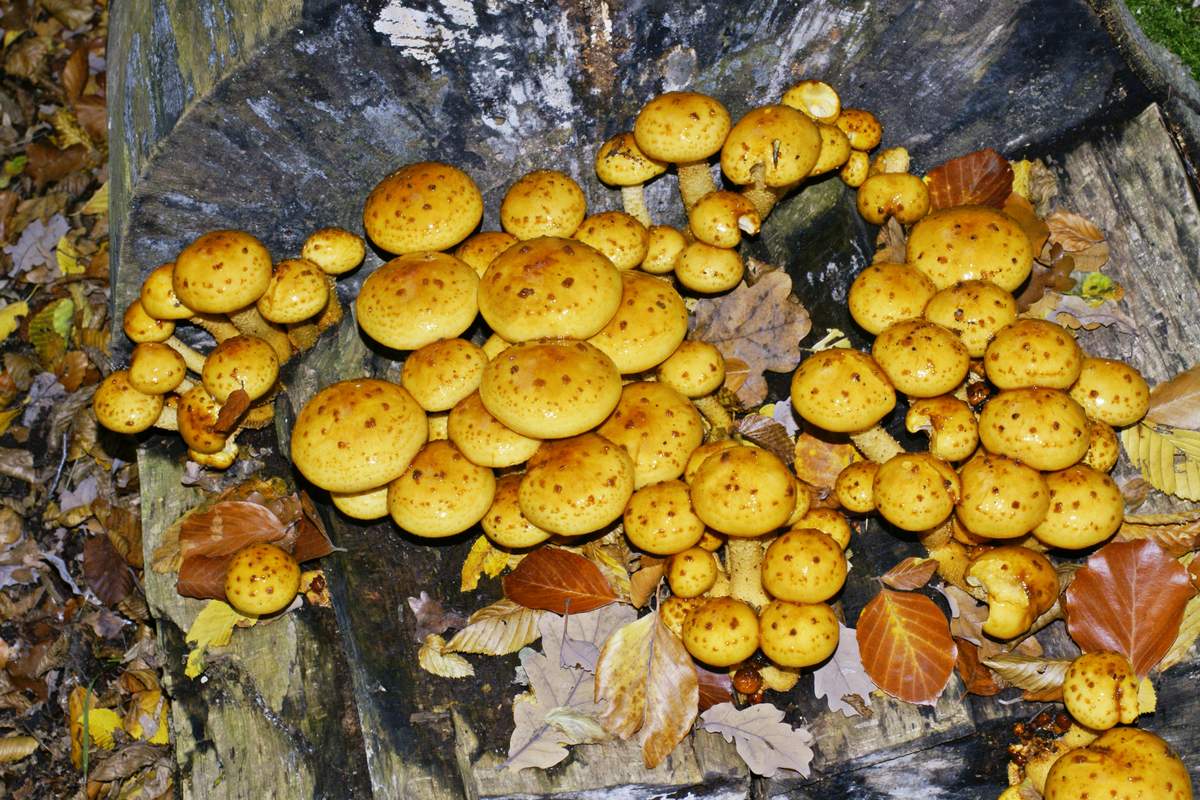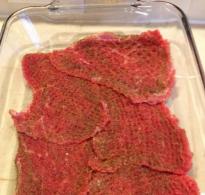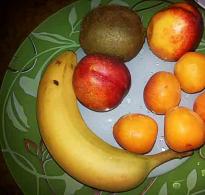What does the autumn honey fungus look like? Royal honey fungus or golden scale
The royal honey fungus received this unusual name from the people. In the scientific literature it is called golden flake. There are 150 varieties known all over the world, thirty of which are found here. This fruit is a great addition to dishes and belongs to the fourth category according to nutritional value. In this article you will learn what they look like, where they like to grow and what can be prepared from them.
Description of mushrooms
Royal honey fungus (golden scale) fully corresponds to its name in appearance and size. The diameter of the cap reaches 20 cm, and its surface resembles a small crown or a studded ball of golden or pinkish color. Old mushrooms develop a rusty or dull yellow hue. White thin plates are hidden under the cap. Pulp young mushroom light. Its stem is thin, if you compare it with the size of the cap (thickness 1-2 cm, height up to 15 cm). It has small scales. the photos of which are presented in the article look very unusual and fabulous.
Favorable environment for royal mushrooms
Golden scale can be found in deciduous forests. They can grow directly on willow) and can sometimes be found on birch stumps. It is better to search for this gift of nature from the end of July to mid-October, but young fruits are very similar to ordinary ones and they grow in groups throughout Russia.
Where to collect honey mushrooms in the Moscow region? 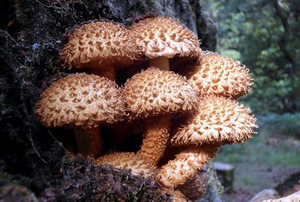
After heavy rains, there is a desire to go into the forest to pick mushrooms. There are several places in the Moscow region where there is a better chance of harvesting a lot of crops. The mushroom picker can go in the Kiev direction through the Alabino and Selyatino stations. In the districts of Rasudov you can find not only honey mushrooms, but also boletus, boletus, chanterelles, milk mushrooms, and porcini mushrooms.
Royal honey fungus can be collected in the vicinity of Iksha station and up to the Tourist platform. It occurs on both sides of the tracks. To collect a lot of fruits, you will need to inspect places 1.5-3 kilometers from the railway.
These amazing gifts of nature are also found in the forests located in the interval from Zelenogradskaya station to Abramtsevo (in the Yaroslavl direction). True, some mushroom pickers believe that the fruits in this place are of poor quality.
You can meet royal honey mushrooms in the Volokolamsk direction, in the north of Opalikha station towards the village of Saburovo and in the south of the village of Nikolskoye-Uryupino. It is better to get to the forest on foot, because it is impossible to travel by car. The mushroom picker will have to walk about 2-3 kilometers.
Fans of picking mushrooms can go to the forests located in the Andreevka and Maryino areas (Leningrad direction). The route should start from the Radishchevo platform. In these places you can find honey mushrooms, chanterelles, boletus, porcini mushrooms, milk mushrooms, boletus mushrooms, and russula.
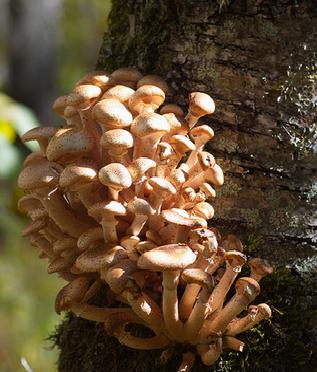
Culinary use and composition
Royal honey fungus is eaten only after boiling. He'll make it delicious salad, soup or sauce. Some housewives even make from these mushrooms amazing pie and marinade.
The product contains: dietary fiber, fatty acids, mono- and disaccharides, water. The golden flake also contains minerals(magnesium, calcium, sodium, phosphorus, iron, potassium) and B1, B2, C, E).
With the coming of the season, lovers quiet hunt mushroom picking begins. One of the desired “trophies” is flakes. These are not just mushrooms - these are royal honey mushrooms. They attract attention with their appearance and are well known to culinary connoisseurs for their unusual rich taste. They are quite easy to find and prepare. But it is important to be able to distinguish edible from poisonous, and for this you need to know all the signs and features of appearance. So that the day is not wasted, you need to know where to look for these mushrooms and in what places they grow.
Royal honey mushrooms appear on the trunks of a variety of trees at the end of summer. Many varieties of these mushrooms choose to grow in both coniferous and deciduous forests.
 For example, fleecy or common scale prefers to settle large families on the stumps of pine and spruce trees. This spiny mushroom has thin leg and a round or conical cap. The diameter of the cap of a young mushroom reaches 8, and a more mature one – 15 cm. It is all covered with brown scales of different sizes. The color of the cap varies from yellow to brownish. The color of the stem matches the color of the cap. Above the blanket, the leg, whose diameter is only 1-3 cm, is also covered with scales.
For example, fleecy or common scale prefers to settle large families on the stumps of pine and spruce trees. This spiny mushroom has thin leg and a round or conical cap. The diameter of the cap of a young mushroom reaches 8, and a more mature one – 15 cm. It is all covered with brown scales of different sizes. The color of the cap varies from yellow to brownish. The color of the stem matches the color of the cap. Above the blanket, the leg, whose diameter is only 1-3 cm, is also covered with scales.
Scaly (common)
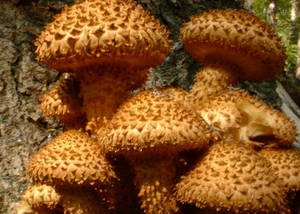 The squamosal scale is different a large number beneficial properties and is considered to be healing. However, another of its properties is hallucinogenicity. However, it is an edible mushroom, which can be eaten after prolonged boiling and other heat treatment. Those who decide to cook and eat common flake are well aware of the ban on eating it in combination with alcohol. One of the components contained in its composition is an analogue of opium, and the consequences of its interaction with alcohol-containing drinks can be unpredictable.
The squamosal scale is different a large number beneficial properties and is considered to be healing. However, another of its properties is hallucinogenicity. However, it is an edible mushroom, which can be eaten after prolonged boiling and other heat treatment. Those who decide to cook and eat common flake are well aware of the ban on eating it in combination with alcohol. One of the components contained in its composition is an analogue of opium, and the consequences of its interaction with alcohol-containing drinks can be unpredictable.
Edible
Edible flake has many fans who know how to cook it correctly and are good at doing it. Besides, dried mushrooms crushed and the resulting powder is used as a base for preparing healing tinctures. After the mushrooms have been boiled in salted water for 30-40 minutes, they can be:
- use as a filling for pies and pies;
- fry;
- stew;
- cook soups and stews with them;
- do mushroom hodgepodge and caviar.
Basic taste qualities Royal mushrooms are hidden in the caps, since the legs become dry and hard after heat treatment. Therefore, it is the caps that are used for salting and marinating, preparing them in the same way as.
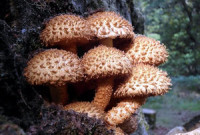 Poplar scale is one of the destructive fungi. It grows on drying trees or stumps. Its white or brown cap is completely covered with large white or gray scales resembling petals. These scales tend to disappear after the mushroom is fully ripe. The stalk of this species is larger and denser than that of other scales. The pulp is white, juicy. This mushroom is not edible, although by the time it ripens, its bitter taste changes and becomes sweet.
Poplar scale is one of the destructive fungi. It grows on drying trees or stumps. Its white or brown cap is completely covered with large white or gray scales resembling petals. These scales tend to disappear after the mushroom is fully ripe. The stalk of this species is larger and denser than that of other scales. The pulp is white, juicy. This mushroom is not edible, although by the time it ripens, its bitter taste changes and becomes sweet.
![]() The fiery scale attracts the attention of participants in a quiet hunt with its bright color. It was named so precisely because of the bright orange color of the cap, like a light shining among the fallen leaves. The peculiarity of the fire flake is that it does not grow in a large family, but in single mushrooms. Although the flesh of this mushroom is dense and juicy, it is not eaten because of its strong and rather unpleasant odor, which it makes when cut.
The fiery scale attracts the attention of participants in a quiet hunt with its bright color. It was named so precisely because of the bright orange color of the cap, like a light shining among the fallen leaves. The peculiarity of the fire flake is that it does not grow in a large family, but in single mushrooms. Although the flesh of this mushroom is dense and juicy, it is not eaten because of its strong and rather unpleasant odor, which it makes when cut.
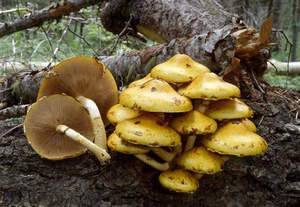 Golden flake is as common as ordinary flake. Its large spherical cap has a glossy bright yellow surface with sparse brown scales. It can be found on an alder trunk or birch stump in damp, swampy areas. This species is directly related to edibles. However, before you start preparing the main dish, the golden flakes should be boiled for 25-30 minutes.
Golden flake is as common as ordinary flake. Its large spherical cap has a glossy bright yellow surface with sparse brown scales. It can be found on an alder trunk or birch stump in damp, swampy areas. This species is directly related to edibles. However, before you start preparing the main dish, the golden flakes should be boiled for 25-30 minutes.
Poisonous species
Picking mushrooms in autumn forest, you need to pay great attention to them appearance so as not to take a poisonous one instead of a tasty edible mushroom. False scale is exactly that and poses a rather serious danger to humans.
Where do they grow and what do royal honey mushrooms look like?
The collection of flakes begins at the end of summer. From August to October, on the trunks of fallen trees in deciduous and mixed forests you can find huge amount these delicious mushrooms. Their edible species easy to distinguish by:
- large rounded convex caps;
- tight legs;
- brown scales.
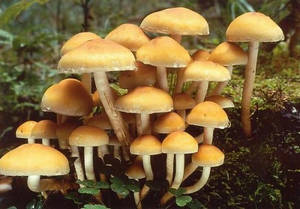 Poisonous false mushrooms stand on a thin pale stalk, but the color of their cap is unusually bright, as if specially attracting attention.
Poisonous false mushrooms stand on a thin pale stalk, but the color of their cap is unusually bright, as if specially attracting attention.
Royal honey mushrooms grow on all types of trees, and some of them, such as poplar scale, are destructive fungi. The scales on the caps fold into an oval shape, reminiscent of an opening flower.
More often, these mushrooms are found in the middle and temperate zones of our country. Their favorite place is marshy areas. Some can be found directly on the trunks of trees, both deciduous and coniferous, while other families settle only on stumps or among dead wood. Edible flakes in most cases grow in large families, which makes them much easier to collect.
Preparation
To properly prepare flake mushrooms, you need to have a good understanding of their types. However, in most cases, mushroom pickers are only interested in two of them:
- golden;
- ordinary.
For cooking, use the caps, cutting off and discarding the stems. Looking for the most suitable recipe preparations, many study with great interest the rules of salting and marinating royal mushrooms. But it is worth noting that great taste The fried flakes are also different. After boiling, they are added to salads, used as a filling for pies, cooked with noodles and made into stews.
To prepare delicious and healthy dishes Honey mushrooms will need to be boiled first to get rid of the bitterness. The cooking process lasts at least 25 minutes, after which the water is drained and the mushrooms are allowed to cool. Now you can begin further processing. For frying you will need onions and vegetable oil, for salad - chicken fillet, eggs, cheese and mayonnaise. But most often julienne is prepared from such mushrooms by baking them in special forms in sour cream under a thick layer of grated cheese.
The flakes that have cooled after cooking should be squeezed out or the remaining water drained, then lightly fried to evaporate excess moisture and give the mushrooms the opportunity to absorb the taste of onions and other seasonings. Now, at your discretion, you can pour cream or sour cream directly into the frying pan and simmer, adding garlic and pepper, or finish frying with potatoes.
One of the most famous recipes preparing flakes - fried mushrooms with potatoes, but pickled and salted mushrooms are always popular. To marinate them, you will need to boil 1 kg of mushrooms in salted water for 20 minutes, then drain the water and let them cool. Meanwhile, prepare the marinade:
- 1 liter of water;
- 100 ml vinegar;
- 5 peppercorns;
- 2 tbsp. coarse table salt.
Pour boiling marinade over mushrooms placed in jars, close nylon covers and after cooling, put it in the cellar or refrigerator.
According to mushroom pickers, the taste qualities of this edible variety are practically not inferior to ordinary honey mushrooms. Mushroom pulp of fruiting bodies is excellent for use in hot and cold appetizers, exotic salads, is widely used in the preparation of first and second courses. Excellent fleshy pulp, as well as the presence of a very unusual and rich taste and aroma, have long made royal mushrooms incredibly popular among chefs in many countries.
Useful and healing properties
Medicinal and beneficial properties mushroom pulp of this variety is due to the very rich chemical composition. , thanks to the high content of microelements and amino acids against the background of low calorie content.
Particularly popular are mushroom dishes for vegetarians and anyone who, due to various circumstances, is forced to adhere to a low-calorie, but completely balanced diet. The pulp contains increased amounts of calcium and phosphorus, which make it possible, if necessary, to fully replace fish dishes.
Where does golden scale grow (video)
Mushroom pulp is characterized by the content:
- dietary fiber – 5.1 g;
- water – 90 g;
- unsaturated fatty acids – 0.2 g;
- monosaccharides and disaccharides – 0.5 g;
- ash – 1.0 g;
- saturated fatty acids – 0.2 g;
- vitamin “B3” (PP) – 10.3 mg;
- vitamin “B1” (thiamine) – 0.02 mg;
- vitamin “B2” (riboflavin) – 0.38 mg;
- vitamin “C” (ascorbic acid) – 11.0 mg;
- vitamin “E” (alpha tocopherol) – 0.1 mg;
- vitamin “PP” (Niacin equivalent) – 10.7 mg;
- Calcium – 5.0 mg;
- Magnesium – 20.0 mg;
- Sodium – 5.0 mg;
- Potassium – 390-400 mg;
- Phosphorus – 43-45 mg;
- Iron – 0.7-0.8 mg.
It is also very important to consider the harm that can be caused by mushroom dishes. Fruiting bodies are not recommended for consumption by persons with gastrointestinal pathologies, as well as those with a history of food allergies or individual intolerances.
False doubles
The most common false double of the edible royal honey fungus is considered to be the inedible Fire Flame (Pholiota flammans). This variety does not contain toxins in its pulp., but the too bitter taste of the fruiting bodies makes them unsuitable for food use. The common saprotroph is characterized by a hemispherical or conical, convex and flat-convex cap, with bent edges, covered with dry scales of bright yellow or yellow-orange color.
The mushroom pulp is yellowish-orange or brownish, with an unexpressed earthy aroma and an unpleasant taste. The plates are of a narrowly adherent type, often arranged, grayish-yellow or brown. The leg region is hollow, with the presence of a fibrous-membranous ring, with a surface covered with bright yellow or brownish scales. Fungal spores are yellowish-brown, oblong. The fruiting bodies of this species grow en masse on dead or highly decaying wood, mainly coniferous trees.
The use of royal honey mushrooms in medicine
If there is a history of anemia, then mushrooms that have high content magnesium and iron will be an excellent therapeutic and prophylactic agent. Among other things, mushroom dishes will be useful if the human body lacks essential minerals and beneficial microelements. Tinctures are made from the pulp of the golden flake, which are effective in the treatment of thrombophlebitis and diabetes, due to the content of anticoagulants. Among other things, consuming fruiting bodies helps prevent active growth and development of tumors.
Useful properties of honey mushrooms (video)
Royal honey mushrooms in cooking
One of the most common species belonging to the Strophariaceae family is quite widely used in culinary purposes. Golden flakes are not just tasty, but also edible mushrooms, but before use, the collected fruiting bodies must be pre-boiled for a quarter of an hour.
Pre-properly prepared royal mushrooms have excellent taste and go well with meat dishes, fried potatoes and stewed vegetables. Golden flakes have proven themselves very well assorted mushrooms, when preparing stews and pie fillings. Among other things, such mushrooms are used to make various, tasty and useful preparations for the winter, including pickling and salting, drying and freezing.
Mushrooms with sour cream sauce
Separate the caps from the stems, and then thoroughly rinse the fruiting bodies under running water and cut into pieces. Boil the fruiting bodies in salted boiling water for half an hour, then drain and cool. Fry on vegetable oil with half rings onions for half an hour, adding spices and seasonings. Pour over the finished dish full fat sour cream, then garnish with finely chopped herbs.
Cream of mushroom soup
Cut the processed cheese into small cubes or grate it coarse grater. Cut the potatoes into medium-sized cubes, cut the onion into half rings, and chop the carrots on a coarse grater, then fry the carrots and onions in heated vegetable oil until golden brown. Pour potatoes and mushrooms into boiling salted water, and after boiling add diced processed cheese. About a quarter of an hour before it is ready, add the roast to the soup, grind in a blender and bring to a boil again with constant stirring. Ready dish decorated with greens and croutons.
Collection places and rules
Any edible species of honey mushrooms most often grow in groups, and royal honey mushrooms are no exception. Fruiting bodies grow en masse on tree trunks damaged by rotting, as well as on old and actively decaying stumps. Occasionally, fruiting bodies may develop near the roots of dead deciduous trees and conifers.
How do honey mushrooms differ from each other (video)
At the time of fruiting, the golden scale enters the last decade of summer. Mushrooms actively bear fruit until the middle of the first autumn month. Royal honey mushrooms are somewhat less common in old pine forest areas and spruce forests. Fruiting bodies should be collected in wicker baskets early in the morning. It should be remembered that overgrown or rotting, worm-eaten honey mushrooms, as well as mushrooms growing along highways or near large cities, should not be collected.
To avoid losing the material, be sure to save it in your social network VKontakte, Odnoklassniki, Facebook, just click on the button below:
Attention, TODAY only!
Golden scale is a mushroom of the Strophariaceae family, genus Foliota or Scale. This is one of the most common species, with the exception of the common scale, in this family.
The Latin name of the mushroom is Pholiota aurivella.
These mushrooms are also called royal honey mushrooms, sulfur-yellow flakes, golden-yellow flakes and willow mushrooms. These are edible mushrooms.
Description of golden flake
The diameter of the cap of these mushrooms reaches truly royal sizes - from 5 to 20 centimeters. The shape of the cap is initially broadly bell-shaped, but with age it changes to flat-rounded. The color of the cap is rusty yellow or dirty golden.
Flaky reddish scales are scattered over the entire surface of the cap. The plates of the golden scale are wide, attached to the stem with teeth; the color of the plates is at first light straw, but as it matures it becomes olive-brown. The pulp is whitish-yellow.
The length of the leg is 7-10 centimeters, and the diameter is 1-1.5 centimeters. The leg is dense, yellow-brown in color with rusty-brown scales. The stalk has a fibrous ring that disappears with age.
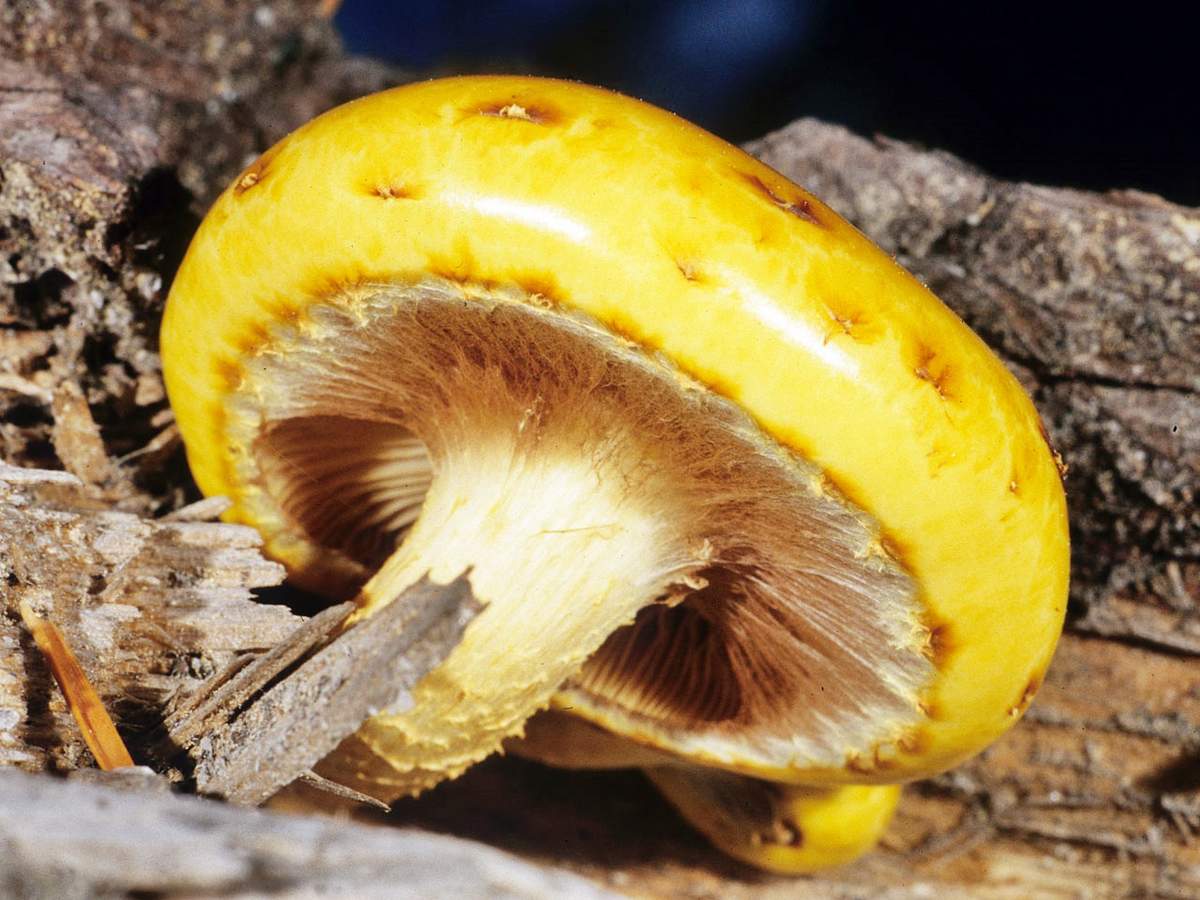
Places of growth and fruiting period of golden scale
These mushrooms grow in large groups. They settle on tree trunks or next to them. Golden flakes bear fruit from August to September. In the Primorsky region they are collected from May to September.
Royal honey mushrooms settle on the trunks of deciduous trees, preferring alder, willow, and less often birch stumps. And sometimes they are found in coniferous forests and swampy areas. Golden scales, like ordinary honey mushrooms, grow in families.
The first caps of golden scales appear in mid-July, and fruiting continues until mid-October. Due to the rare appearance of golden scales, they are confused with false honey mushrooms, which grow in the same places.
The use of royal mushrooms in cooking
Golden scales are edible mushrooms. Before use, they should be pre-boiled for 20 minutes. They have excellent taste. These mushrooms are used in salads and main courses. The flakes go well with fried potatoes. In addition, they are used to make preparations for the winter.
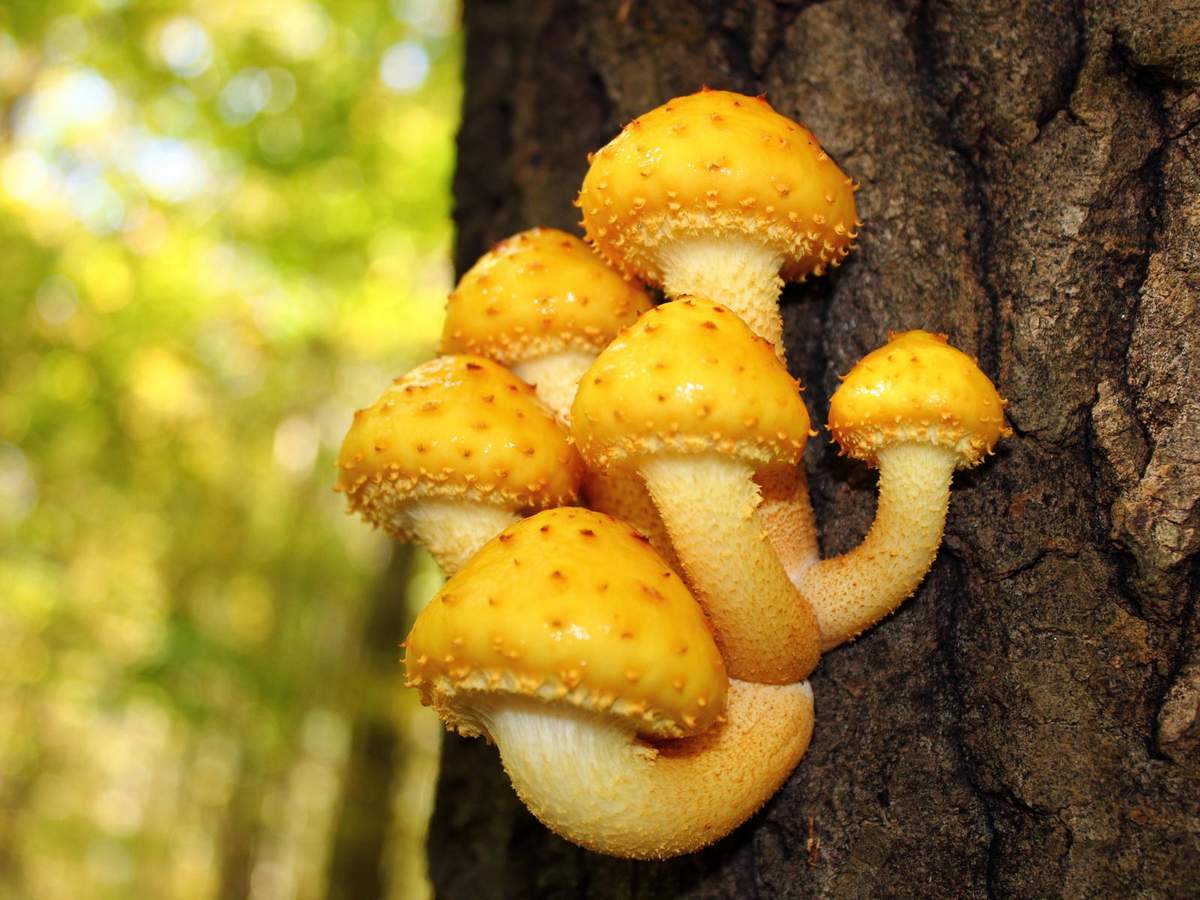
The flakes collected in coniferous forests differ from the flakes growing in deciduous forests; they have a bitter taste. Therefore, they are more suitable for pickling and salting. These mushrooms are also great for freezing and drying.
Golden flakes are a source of vitamin C, E and PP. In addition, they contain magnesium, phosphorus, potassium, calcium, iron and sodium. The calorie content of royal mushrooms is 22 calories per 100 grams.
But, despite the distribution of golden flake and its good recognition, these mushrooms are not collected so often. This is due to the fact that few people know these mushrooms. Only real connoisseurs and gourmets of mushroom delicacies put them on the same level as autumn honey mushrooms.
Other mushrooms of this genus
Scaly mucous membrane - conditionally edible mushroom. At a young age, the shape of the cap is bell-shaped, and as it grows, it becomes prostrate or slightly concave; in adulthood, the edges of the cap rise slightly. The color of the cap is yellowish or bright brown, the central part is usually darker. In rainy weather, the pulp becomes mucous-sticky. The diameter of the cylindrical leg is approximately 1 centimeter, and its length reaches 10 centimeters. At first the leg is cotton-like, but over time it becomes almost hollow. There is a ring on the stem, but it quickly disappears.
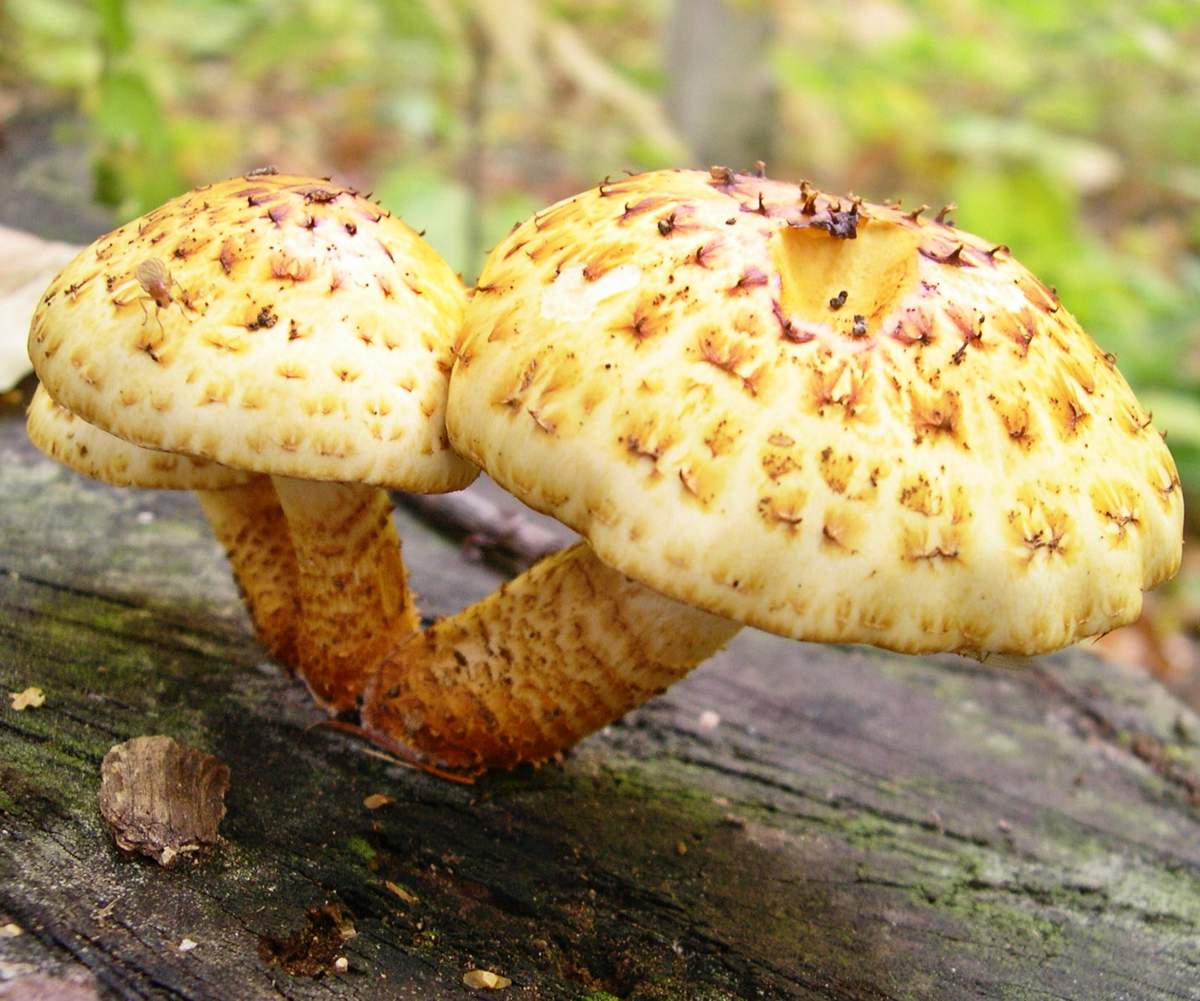
Slimy scales grow on rotted wood. These mushrooms bear fruit from August to October.
The cinder or coal-loving scale has a cap from hemispherical to prostrate in shape. The diameter of the cap ranges from 2 to 6 centimeters. The color is heterogeneous orange-brown. In damp weather the cap becomes slimy. Often the edges of the cap are covered with scraps of the bedspread. The lower part of the leg is covered with brown fibers, and upper part lighter.
The diameter of the leg is 1 centimeter, and the height reaches 6 centimeters. The mark of the ring on the leg is almost invisible.
Cinder flake begins to appear in May and bears fruit until October with variable frequency. These mushrooms settle on charred wood and old fireplaces. Cinder scales are considered inedible.
